Pediatric Advanced Life Support
Pediatric Advanced Life Support
All 64 résultats
Trier par
Pediatric Advanced Life Support Exam | PALS Test Exam 2024 with Questions and 100% Correct Answers
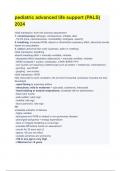
-
pediatric advanced life support (PALS) 2024
- Examen • 21 pages • 2024
-
- 7,09 €
- + en savoir plus
initial impression; from the doorway assessment 1. consciousness; lethargic, unresponsive, irritable, alert - TILCS (tone, interactiveness, consolability, look/gaze, speech) 2. breathing; increased WOB, absent or diminished respiratory effort, abnormal sounds heard w/o auscultation 3. colour; abnormal skin color (cyanosis, pallor or mottling)
Pediatric Advanced Life Support Pediatric Advanced Life Support Pediatric Advanced Life Support
PEDIATRIC ADVANCED LIFE SUPPORT QUESTIONS AND ANSWERS (2023/2024) (VERIFIED ANSWERS)

-
Pediatric Advanced Life Support Updated FINAL EXAM 2024-2025
- Examen • 7 pages • 2024
-
- 12,10 €
- + en savoir plus
Pediatric Advanced Life Support Updated FINAL EXAM A 12-year-old child being evaluated in the pediatric intensive care unit displays the following ECG waveform. The team interprets this as which arrhythmia? Correct Answer: second degree Laboratory tests are ordered for a child who has been vomiting for 3 days and is diaphoretic, tachypneic, lethargic and pale. Which test would the provider use to determine the adequacy of oxygen delivery? Correct Answer: Lactate A 9-year-old pa...
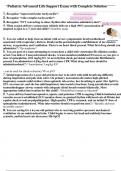
-
Pediatric Advanced Life Support Exam with Complete Solution
- Examen • 23 pages • 2023
-
Disponible en pack
-
- 9,45 €
- + en savoir plus
Pediatric Advanced Life Support Exam with Complete Solution Recognize *supraventricular tachycardia* - 2. Recognize *wide-complex tachycardia*: 3. Recognize *SVT converting to sinus rhythm after adenosine administra- tion*: 4. What oxygen delivery system most reliably delivers a high (90% concentration of inspired oxygen to a 7-year-old child?: Nonrebre mask 5. You are called to help treat an infant with severe symptomatic bradycardia (heart rate 66/min) associated with respiratory dis...
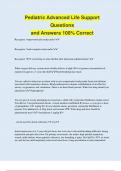
-
Pediatric Advanced Life Support Questions and Answers 100% Correct
- Examen • 28 pages • 2024
-
- 10,40 €
- + en savoir plus
Recognize *supraventricular tachycardia* Recognize *wide-complex tachycardia* Recognize *SVT converting to sinus rhythm after adenosine administration* What oxygen delivery system most reliably delivers a high (90% of greater) concentration of inspired oxygen to a 7-year-old child?Nonrebreathing face mask You are called to help treat an infant with severe symptomatic bradycardia (heart rate 66/min) associated with respiratory distress. Bradycardia persists despite establishment of an effec...
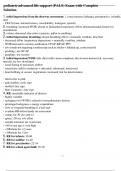
-
pediatric advanced life support (PALS) Exam with Complete Solution
- Examen • 18 pages • 2023
-
Disponible en pack
-
- 9,45 €
- + en savoir plus
pediatric advanced life support (PALS) Exam with Complete Solution 1. initial impression; from the doorway assessment: 1. consciousness; lethargic, unresponsive, irritable, alert - TILCS (tone, interactiveness, consolability, look/gaze, speech) 2. breathing; increased WOB, absent or diminished respiratory effort, abnormal sounds heard w/o auscultation 3. colour; abnormal skin color (cyanosis, pallor or mottling) 2. initial impression; breathing: absent breathing effort = manually ventila...
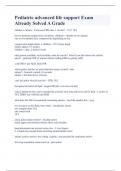
-
Pediatric advanced life support Exam Already Solved A Grade
- Examen • 14 pages • 2023
-
Disponible en pack
-
- 7,56 €
- + en savoir plus
Pediatric advanced life support Exam Already Solved A Grade children + infants - 2 rescuers CPR ratio, 1 rescuer? - 15:2, 30:2 how to perform compressions on infants. children? - thumbs or two fingers one or two handed chest compressions depending on size compression depth infants + children - 1/3 of chest depth infants approx 1.5 inchest children - same, 2 inches [4 cm] only person available, see kid chillin, what do you do?. what if you did witness the cardiac arrest? - perform...
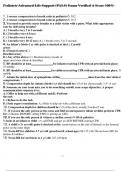
-
Pediatric Advanced Life Support (PALS) Exam Verified A Score 100%
- Examen • 15 pages • 2023
-
Disponible en pack
-
- 8,03 €
- + en savoir plus
Pediatric Advanced Life Support (PALS) Exam Verified A Score 100% 1. 1 rescuer compression to breath ratio in pediatrics?: 30:2 2. 2 rescuer compression to breath ratio in pediatrics?: 15:2 3. You need to provide rescue breaths to a child victim with a pulse. What is the appropriate rate for delivering breaths? A.) 1 breath every 3 to 5 seconds B.) 2 breaths every 6-8 secs C.) 1 breath every 6 secs D.) 1 breath every 10-12 secs: A.) 1 breath every 3 to 5 seconds 4. An infant's (birth...

Comment a-t-il fait cela? En vendant ses ressources d'étude sur Stuvia. Essayez-le vous-même ! Découvrez tout sur gagner de l'argent sur Stuvia





